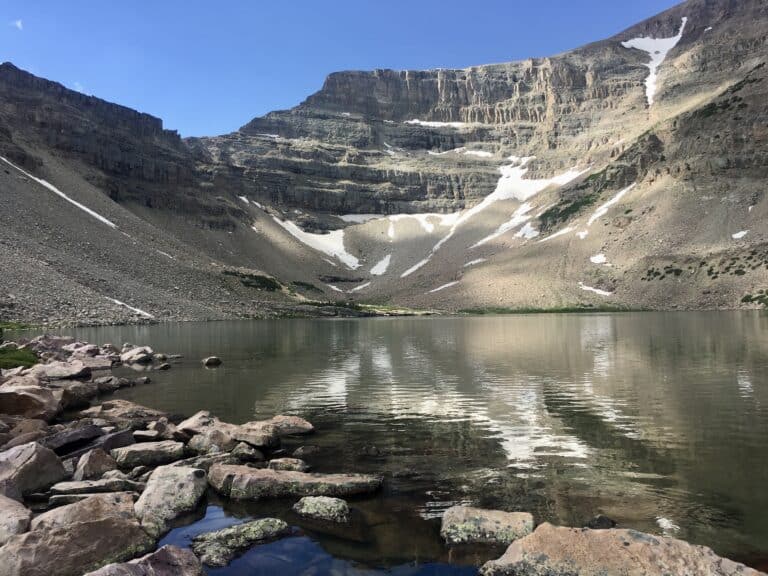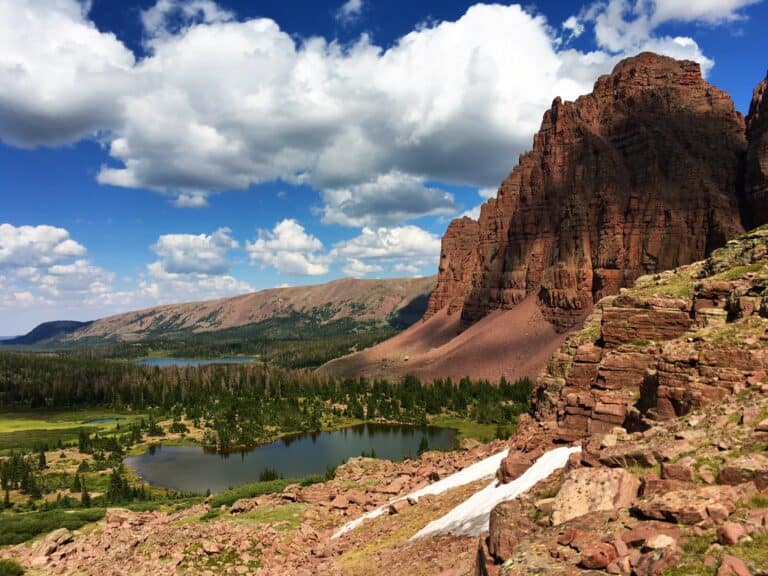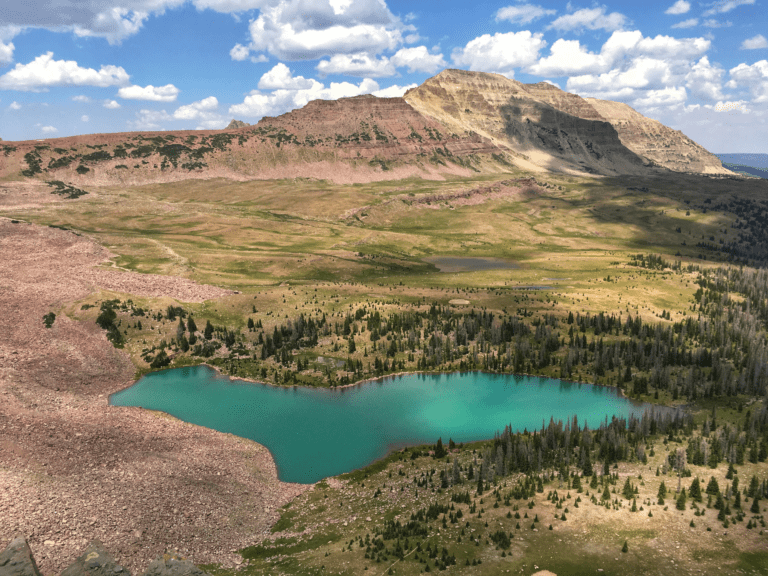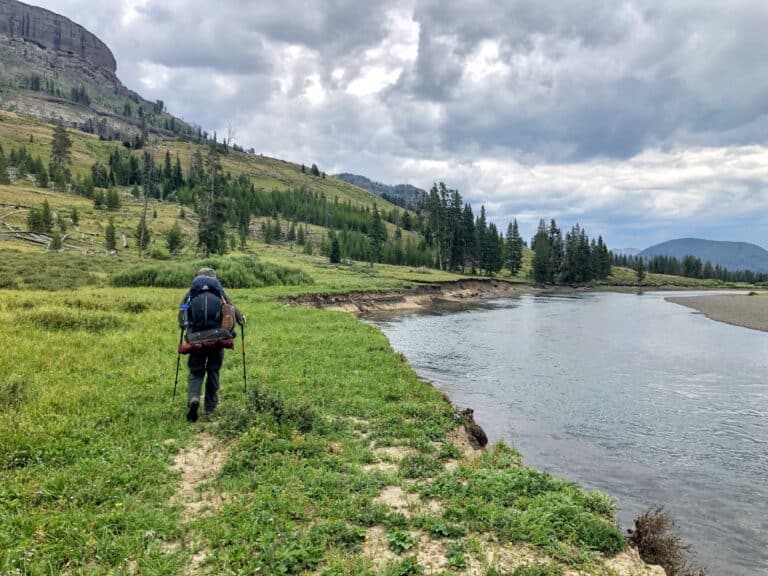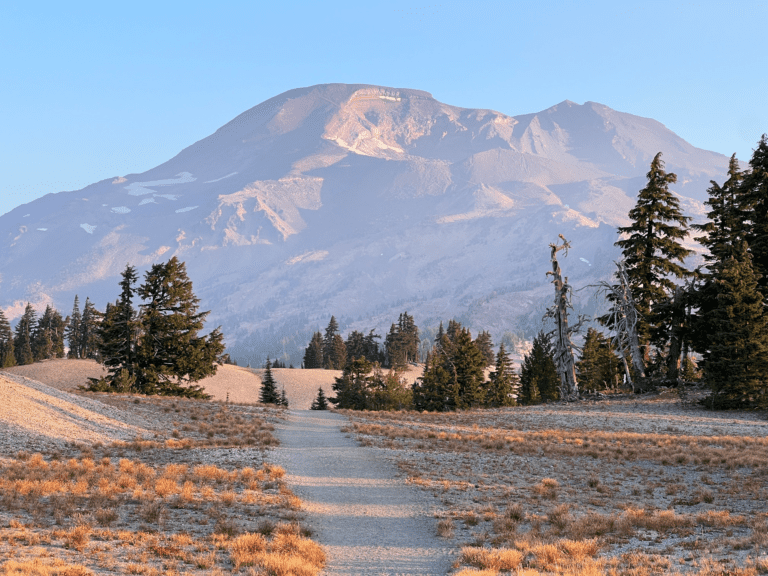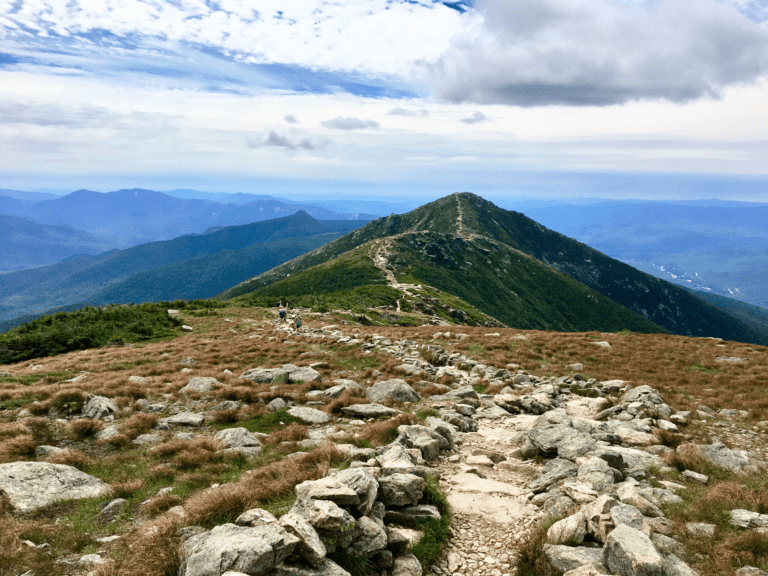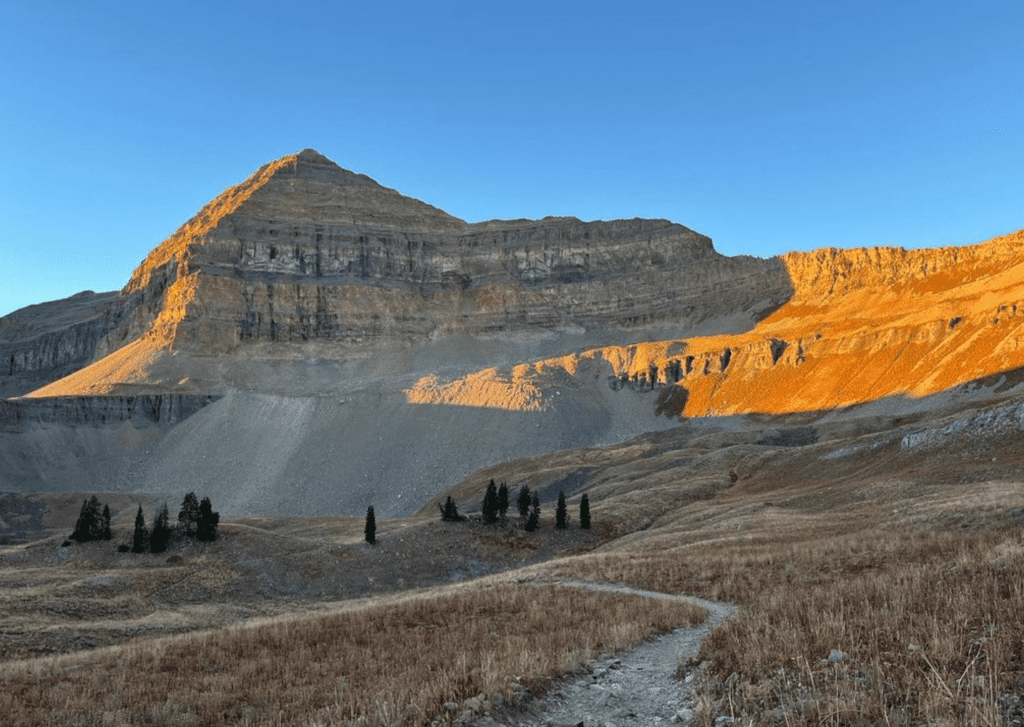
At a Glance
Distance: 14.0 miles
Elevation Gain: 5,000 ft
Trailhead: Timpooneke Trailhead
Route Type: Out and Back
Best Time: July to September
Red Tape: None
Difficulty
Grade: 14%
Exposure: Moderate near the summit
Class: Class 1
Overall Difficulty: Difficult
Description
Mount Timpanogos, known as “Timp” by the locals, is located in the Wasatch Mountain Range. It is the second tallest peak in the range and rises to an elevation of 11,752 feet. Only nearby Mount Nebo is taller.
Mount Timpanogos is also one of eight ultra-prominent peaks in Utah. An ultra-prominent peak is a mountain summit with a topographic prominence of at least 5,000 feet. There are 57 such mountains in the lower 48.
Mount Timpanogos is well known and easily identifiable by the locals. Its appearance from the Utah Valley floor is both rugged and steep. From several vantage points, the summit of Mount Timpanogos looks like a long flat ridge.
The Mountain Timpanogos hike is a right of passage for locals. After I moved to Utah, anyone I met who learned that I enjoyed hiking and peakbagging would inevitably ask, “have you been to Mount Timpanogos?” This makes the hike one of the more popular hikes in the Wasatch mountains.
There are two main trails of equal popularity to the summit; the Aspen Grove Trail and the Timpooneke Trail. Both routes are similar in mileage and elevation gain.
Aspen Grove Trail
The Aspen Grove Trailhead lies along the Alpine Loop Road, approximately 2.5 miles after the Sundance Ski Resort. The drive heading south from Salt Lake City takes about an hour.
Just as with parking in Big Cottonwood Canyon and Little Cottonwood Canyon, the parking lot at the Aspen Grove Trailhead fills very fast. On the weekends in the summer, expect the parking lot to fill up before 7am.
There is a vault toilet in the parking lot.
There are two primary trails at the Aspen Grove Trailhead. The Mount Timpanogos Trail and the Stewart Falls Trail. Stewart Falls is a popular hike and a perfect destination for new hikers and children, but that is for another day.
As the trail begins, you immediately find yourself out of the forest and into more shrubby and open terrain. The first 1.5 miles of trail has an elevation gain of roughly 1200 vertical feet. At this point, you arrive at Timpanogos Falls.
The falls can be magnificent depending on the time of year and the amount of snow in the high elevations.
The snowfall from the previous winter also determines how the next section of your hike will go, as your next destination is the Primrose Cirque. This section of the hike is infamous for holding snow into late July. More often than not, a good set of hiking poles is enough to get by, but you might need microspikes. I have found this section sketchy in a heavy snow year the week of July 4th.
The hike across the Primrose Cirque is about a mile long and has an elevation gain of 1,000 feet. At this point, you are now ~3 miles and 2,300 vertical feet into a long hike.
The next section of the Aspen Grove route has several switchbacks up a valley before leveling out for some mid-hike relief as you approach Emerald Lake.
Emerald Lake is known for its crystal clear waters, which are a vibrant emerald green color, hence its name. Emerald Lake is the most popular place to turn a Mount Timpanogos hike into an overnight expedition. The abundance of mountain goats suggests that water filtering is a good idea.
From Emerald Lake, a side trip to the summit of nearby Roberts Horn is an easy secondary objective. The hike to the summit of Roberts Horn is straightforward, with only a few actual bushwacking steps required.
At the summit of Roberts Horn, you’ll find a random giant Buddha. I still don’t understand why it’s there and who would carry that on such a long hike.
Your next destination is the Timpanogos saddle. From Emerald Lake, an easy crossing of the Timpanogos Basin and some moderate elevation gain will put you at the saddle, where you’ll meet up with the Timpooneke Trail. This upper basin will also hold snow late into the season, so please use caution.
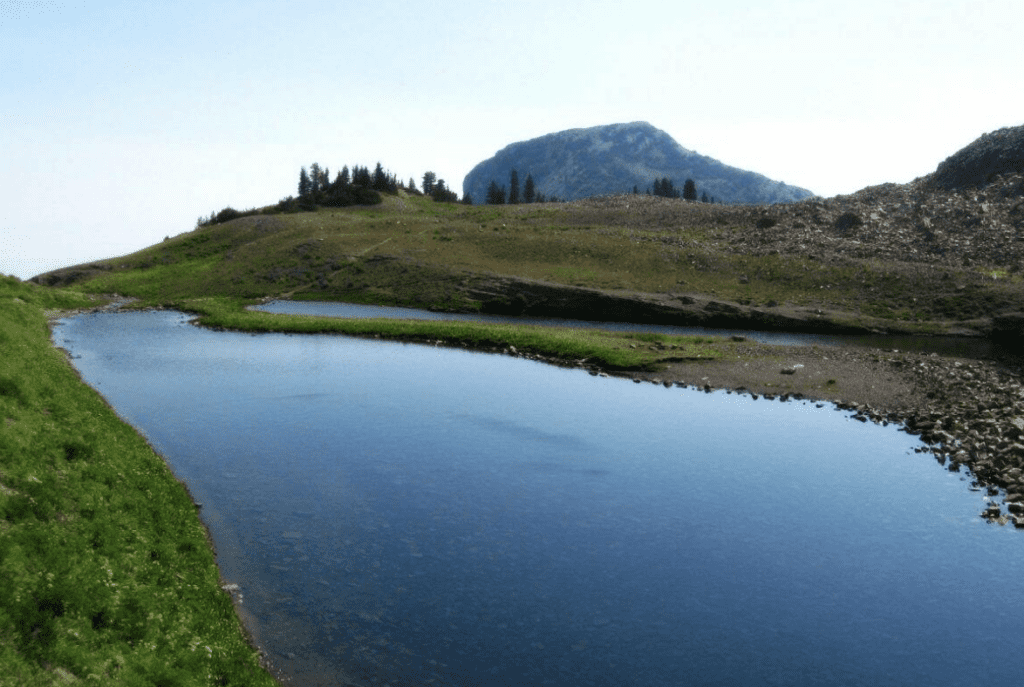
Timpooneke Trail
The Timpooneke Trailhead is accessed via American Fork Canyon. After entering the canyon Alpine Scenic Highway, you’ll pass the Timpanogos Cave National Monument on your right-hand side.
Approximately 2.5 miles after passing the National Monument, the road forks. A left will take you to the Tibble Fork Reservoir recreational area, and the right will point you toward Mount Timpanogos.
A little more than 3 miles down the road, you’ll pass signs for the Timpooneke Campground and Forest Service Road 56 on the right-hand side. Just past the group sites of the Timpooneke Campground, you’ll find the Timpooneke Trailhead.
The parking lot has close to 100 spaces and a vault toilet, just like the Aspen Grove Trailhead. Similar to the parking situation for the Aspen Grove route, the Timpooneke route is no better.
Expect the parking lot to fill up by 7am on the weekend. With Mount Timpanogos being a long hike, an early start in the heat of summer is a good idea.
The Timpooneke Trail begins directly from the parking lot. The first landmark on your hike along the Timpooneke Trail is Scout Falls, 1.4 miles in.
Scout Falls is a popular destination for families and Timpookene Campground guests. Scout Falls is also an excellent place to take your first break and fill up on water.
From here, the Timpooneke Trail meanders along the South Fork and begins to climb. You’ll reach the upper basin in another 3.4 miles and 2400 vertical feet. The Timpanogos Basin has several trails. The upper basin area is known for overnight camping as the space is open, flattens out, and water is generally abundant.
When you arrive at the upper basin, I generally stay to the right and take the trail towards the Mt Timpanogos Saddle. Heading to the left will meet up with the Aspen Grove Trail and ultimately to Emerald Lake. This is also another option for overnight camping.
If there is snow, the Timpanogos Basin can be a choose-your-own-adventure. No matter your path, aim towards the Timp saddle.
When the snow recedes (almost always by early August), the Timpooneke Trail through the upper basin is flush with beautiful wildflowers. Mount Timpanogos makes for an imposing background for pictures. The occasional herd of mountain goats adds to the natural beauty.
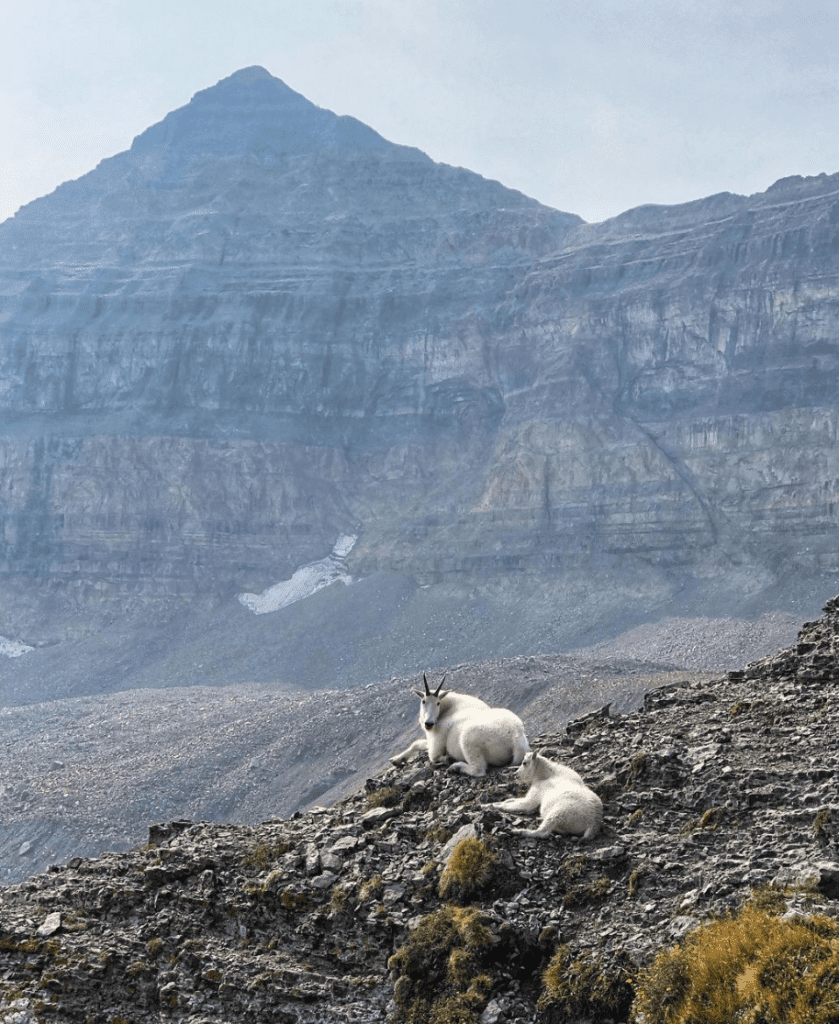
Saddle to Mt Timpanogos Summit
The Mount Timpanogos saddle provides some fantastic views down into Utah Valley. To your right is a faint ridge trail that aims towards North Timpanogos. The path has guaranteed solitude for those looking to find it in an otherwise crowded peak.
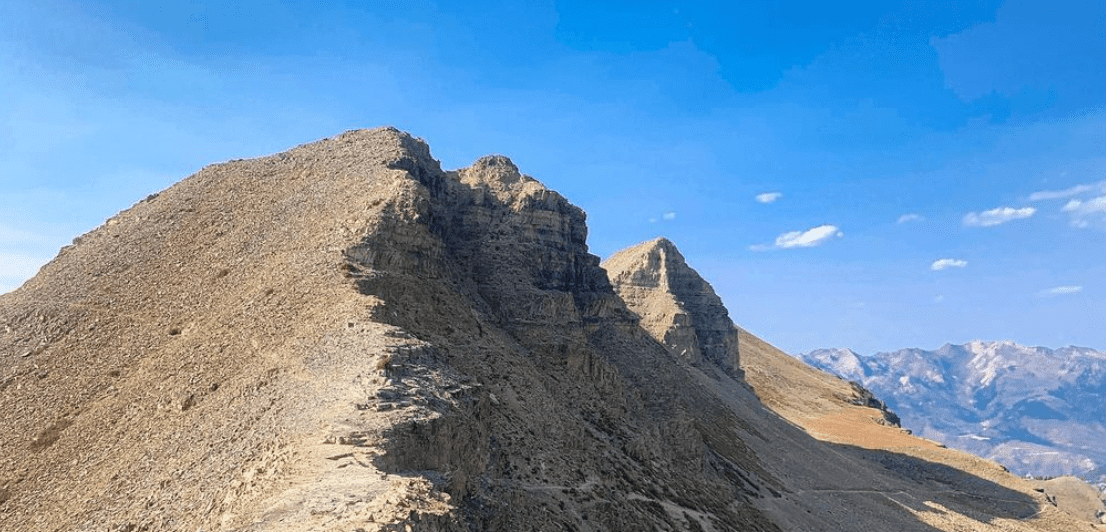
To your left is the trail that will take you to the summit of Mount Timpanogos. It’s roughly 0.75 miles to the summit from the saddle. Occasionally there are loose rocks to navigate along the ridge trail. There is also the feel of exposure because you’re looking down over a vertical mile onto Utah County.
The terrain in this area looks more exposed and scarier than it really is. It’s an excellent part of the hike to snap a few pictures of your hiking partner, as the vertical background will appear far more extreme for future storytelling.
The Timpanogos summit has a small hut that has become a landmark. I find it kind of ugly and wish it wasn’t there. It acts like a graffiti-covered summit register.
From the Timpanogos summit, you can see the entirety of the Wasatch Range. To your south is Nebo Peak, the highest peak in the Wasatch Mountains and the only one in the range taller than Mount Timpanogos. While looking south, you can also make out Cascade Mountain, Provo Peak, and Spanish Fork Peak.
To your west is Utah Valley. You’ve been looking down at the valley since hitting the saddle. Utah Lake is easy to make out. The triangular peak directly to your north is Box Elder Peak. You can easily make out the erosion digging the army corps of engineers did decades earlier.
Further north is the Salt Lake Valley, including all of Salt Lake County. Salt Lake City is hidden behind Lone Peak. To the east are the Uintas Mountains. You can make out Kings Peak on a clear day.
Some of the Salt Lake City locals have a goal to hike up all of the 11k-foot peaks in the Wasatch Mountains. Mount Timpanogos is one of them, as are nearby and seldomly visited North Timpanogos and South Timpanogos.
If you’re in that group, I recommend hiking all three peaks in one long Timpanogos hike. There is a social trail that continues on from the Timpanogos summit heads to South Timpanogos. The ridge trail has limited exposure and difficulty. Mountain goats are famous in this stretch.
Views from South Timpanogos include Provo Canyon, Utah Valley, and Utah Lake. You can also make out the Deer Creek Reservoir to the east and the entirety of the Mount Timpanogos ridge. The best views are captured by walking a few hundred feet past the summit heading northeast.
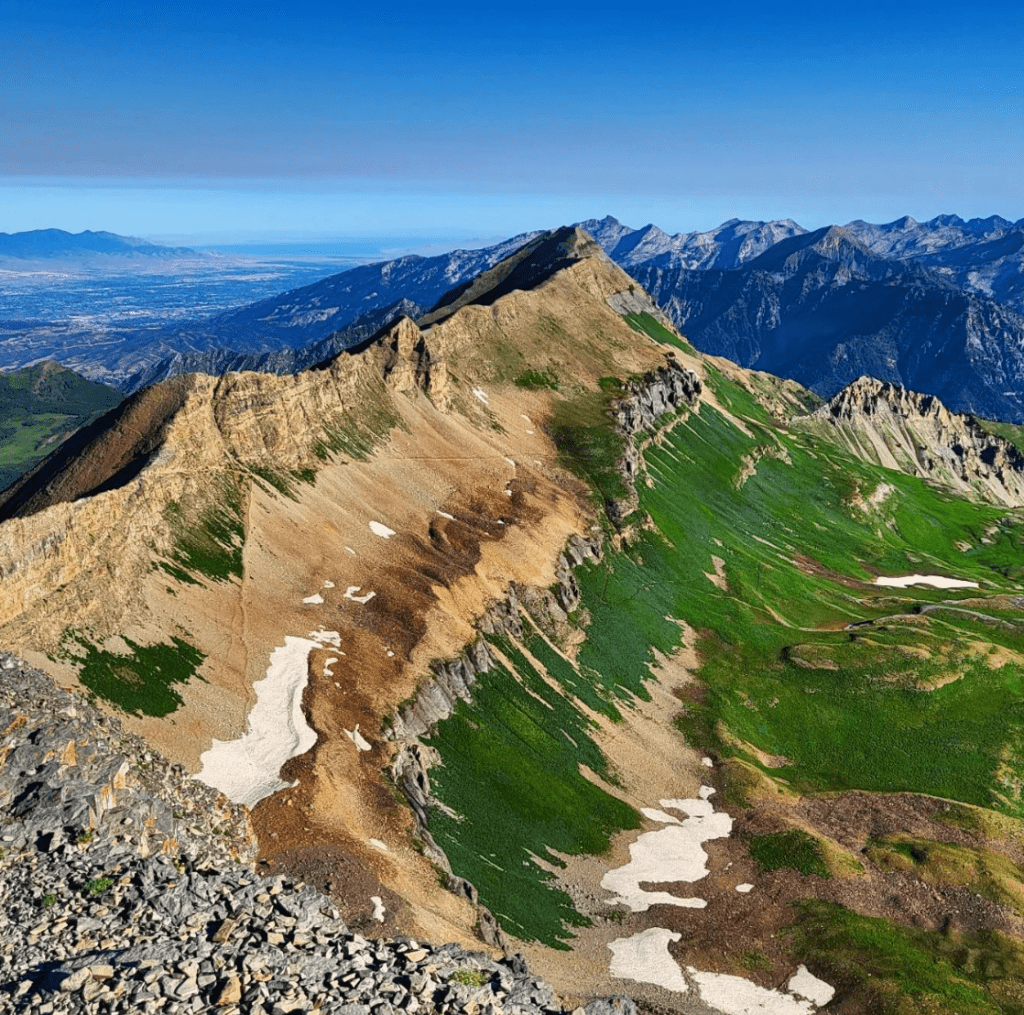
From South Timpanogos, it is possible to make the hike a lollipop instead of an out-and-back by connecting to the Aspen Grove Trail. The connection is made by descending down the Timpanogos glacier that empties into Emerald Lake. The glacial ice is what gives Emerald Lake its color. To hike this route almost always requires crampons and an ice axe.
A more realistic option for the average hiker is to connect the Aspen Grove Trail and the Timpooneke Trail to get the best of both approaches. This requires two parties in your hike to set up a car shuttle.
If you’re on your own, you’ll need a generous friend to drop you off at the Timpooneke Trailhead in the morning and pick you up on the Aspen Grove side of Mount Timpanogos (or vice versa).
As you hike down, remember to get your hiking poles out if you’re the type that carries them in your bag on the ascent. Both routes are known for their wildlife sightings and beautiful wildflowers. Keep your eyes open for mountain goats. Every Mount Timpanogos hike has at least one mountain goat sighting.
FAQs
Is Timpanogos a hard hike?
The hike up Mount Timpanogos is physically demanding but not technical. The long approach and 5,000 feet of elevation gain requires hikers to have solid conditioning to make it to the Timpanogos summit. The time spent above the tree line adds a degree of sun exposure in the summer months, increasing the hike’s physical demands.
Winter conditions, especially snow, change the technical nature of the hike. A winter ascent, generally tackled from the Everest Ridge, requires mountaineer gear, avalanche experience, and mountaineering experience.
The presence of snow on the trail in early summer can also vary the technical nature of the hike. Often poles and microspikes are sufficient. One positive to Mount Timpanogos being a popular hike is that finding a few recent pictures on Instagram to gauge the snow is pretty straightforward.
How long does it take to hike to the top of Timpanogos?
Hiking to the top of Mount Timpanogos is an all-day adventure that will take the average hiker will take 8-12 hours, including stops and time at the summit. Times will vary widely depending on conditions and your level of fitness.
What does the name Timpanogos mean?
Mount Timpanogos gets its name from the Timpanogos Native American tribe that inhabited the area. The Timpanogos Tribe settled areas between Utah lake and the east side of the Uinta Mountains. Timpanogos means “rock” or “crown of the mountain.”
What is the best time of year to hike Mount Timpanogos?
The best time of year to hike Mount Timpanogos is from July to September. Hikes in June can be pleasant, but you should be prepared for snow.
Best of Instagram
Trail Map
Mount Timpanogos Hike Video
Alternate Routes
Aspen Grove (covered above): 14 miles, 5,000 feet of elevation gain
Timpooneke Trail (covered above): 14 miles, 5,000 feet of elevation gain
Everest Ridge: There are several routes to get to the crux of the route, which is to arrive at the saddle between Big Baldy and Timpanogos. The Everest Ridge is the southwest ridge and is a name given to the route from a 1990’s Mount Everest expedition team from Utah. The team utilized this route during the winter season for their training purposes.

